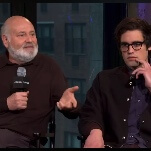Readers praise the power and joy of Mario’s mustache
The Power ’stache
The “Bodies” edition of Special Topics In Gameology came to a close this week with an essay from Derrick Sanskrit about the ways game have used hair to define and connect us to characters. Derrick backed it up with some of his own graphics, including a chart that compared a Mario with and without hair from across some of his earliest appearances. All those Mario sprites lined side-by-side gave duwease a revelation:
I always thought Mario’s sprites throughout the NES games got more expressive as the developers got better at pushing the hardware. Looking at it here, though, it’s just different reshufflings of the sprite size and the NES’ three-color per spire limit. The main trick they seem to have found is to make his hair darker, so that they can re-use the color as an outline, which does give it a more defined, cartoonish look. It’s still a clever trick, but not quite the mind-blowing graphical upgrade I seem to remember from my childhood—though that may have been inflated by the insane hype-train for Super Mario Bros. 3. Between the schoolyard, Nintendo Power, and its unveiling in the big finale of The Wizard, it seemed like the Second Coming Of Mario at the time.
Venerable Monk thought up a plausible explanation for why the jump between Marios seemed more impressive at the time:
Maybe it wasn’t the inclusion of extra detail, but the inclusion of extra sprites that impressed young you? Take a look at the differences between the Super Mario Bros. sprite sheet and the Super Mario Bros. 3 sprite sheet for Mario. The SMB3 sheet seems to capture pretty much everything in the original sheet, but it also has extra sprites, like an intermediate stage between standing and full-out run and that swan-dive-esque jump animation that only plays when the P meter is full.
There are also slight differences in the running sprites that give Mario’s body the appearance of turning from side to side, which is completely absent in the original. I think it’s the combination of those few extra sprites and the subtle tweaks to indicate motion that make SMB3 look so much more impressive. Throw in the tail animations for the Raccoon Suit and the hat grab when Mario ducks, and you’ve got a charming new iteration on the classic sprite.
Elsewhere, jakeoti dug deeper into the ways Nintendo has used Mario’s mustache to give him so more emotion and character:
Mario’s mustache doubled back then (and still works today) as a sign of joy. The fact that they made it curve upward gives the impression that he is constantly smiling, like he’s enjoying his job. That helps the player have fun. And it didn’t stop back then; nowadays, his mouth is subtle. It’s not deeply shaded, so it’s hard to notice that it’s there at a quick glance. But that dominating mustache draws the eye and conveys happiness no matter what.
For example, look at his selection icon in the latest Smash Bros. He still holds a serious expression, which matches up well with the game’s tone of being serious, but at the same time, he looks so happy, you just can’t wait to play with him and have a good time.
Mario’s mustache has also been a defining characteristic in dialogue for the Mario RPGs. Characters often times recognize Mario not by his overalls and hat but by his facial hair. Many comment on the strength and bushiness of both Mario and Luigi’s mustaches, making them the key to their identity. In the Mario And Luigi series, “Mustache” is one of your stats that you can increase upon leveling up, giving you better luck and earning discounts in shops. I would even say that it is a somewhat Freudian, phallic concept in the RPGs. Just look at how it goes down when Luigi’s mustache is insulted. Yep. No compensating there.






















![HBO teases new Euphoria, Larry David, and much more in 2026 sizzle reel [Updated]](https://img.pastemagazine.com/wp-content/avuploads/2025/12/12100344/MixCollage-12-Dec-2025-09-56-AM-9137.jpg)

















